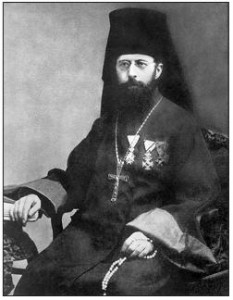Editor’s note: The following interview, with Fr. Sebastian Dabovich, originally appeared in the Seattle Post-Intelligencer, and was reprinted in the Macon (GA) Telegraph on July 31, 1903. We’re reprinting it here in full.
Abbot Sebastian Dabovich, a priest high in the circles of the orthodox Russian church, passed through Seattle yesterday on his way to inspect the mission of that church in Alaska. The abbot is an authority on the Russian church in Alaska, and spoke very interestingly of the work there in an interview. He said:
Next to the Roman Catholics the Russian [Church] has the greatest number of communicants of any church in the civilized world. On the coast the two great strongholds of the Russian church are in Alaska and a section of California. Last year I made a trip of 6,000 miles in and along the Alaskan coast, inspecting our mission stations.
On this trip I go to consecrate a new church in Douglas Island, opposite Juneau, the communicants of which are mostly miners of the Slavonic race. From there I go to Sitka to look after the work. On the whole, the trip will be largely in the nature of a rest for me.
The work of our missions in Alaska is a continually growing one, and owing to the great floating population of that country, a work that is continually changing to meet the new demands.
The majority of native Alaskans are Christianized. Our own church has been organized in Alaska for nearly 110 years. Since the country has been occupied by the United States the Roman Catholics, Episcopalians, Presbyterians, Baptists, Methodists, and several other missionaries have come to spread Christianity.
The Russians of Alaska in early days had some land grants in California, and they occupied the whole of what is now known as Sonoma county. From here they shipped wheat and fruit to Alaska. The quality of fruit, which took a prize in the World’s Fair at Chicago in 1893, came from Sonoma, and it was planted by the Russians, the seeds having been brought across Siberia from the Caucasian country and elsewhere.
Long before any one dreamed of a city of San Francisco there in San Francisco bay, in the little town of Sausalito flourished an iron foundry and machine shops. There in Sausalito the Russians built the first steamer that ever steamed to the north on the Pacific ocean. The engineer that brought the first steamer to Alaska is still living, now an old cripple of more than ninety years. He is an old Alaskan Creole, and lives with a son in Sedovia, Alaska.
On entering the old Russian capital of Sitka, the first building which attracts attention is the cathedral of St. Michael’s. The clock in the tower of this old church was made and put in its present position by Innocentius, the first bishop of Alaska.

Is there any corroboration about Sausalito? I know that the ship that took the evacuees from Fort Ross stopped there, but I don’t remember any other activity of hte Russians there.